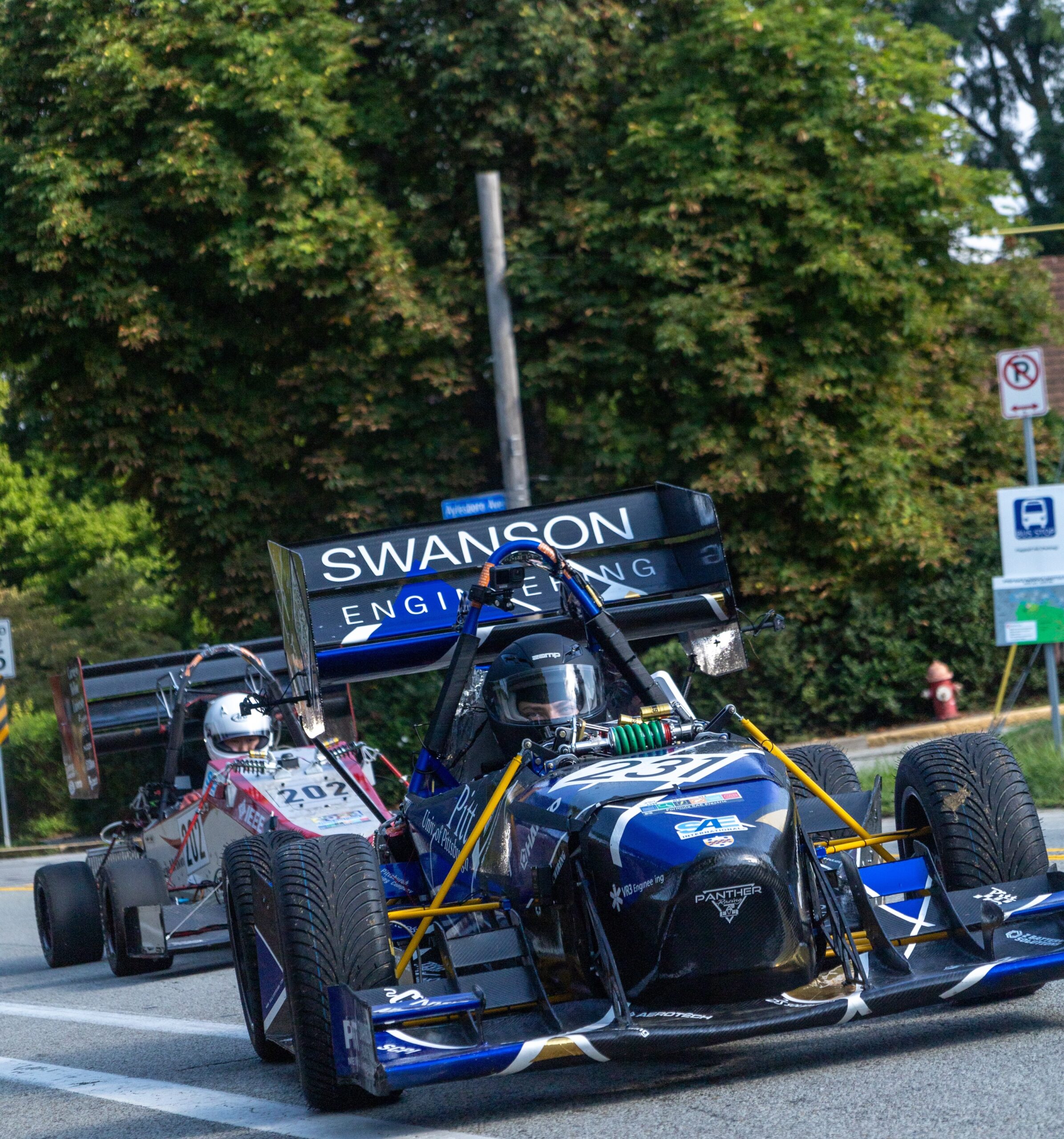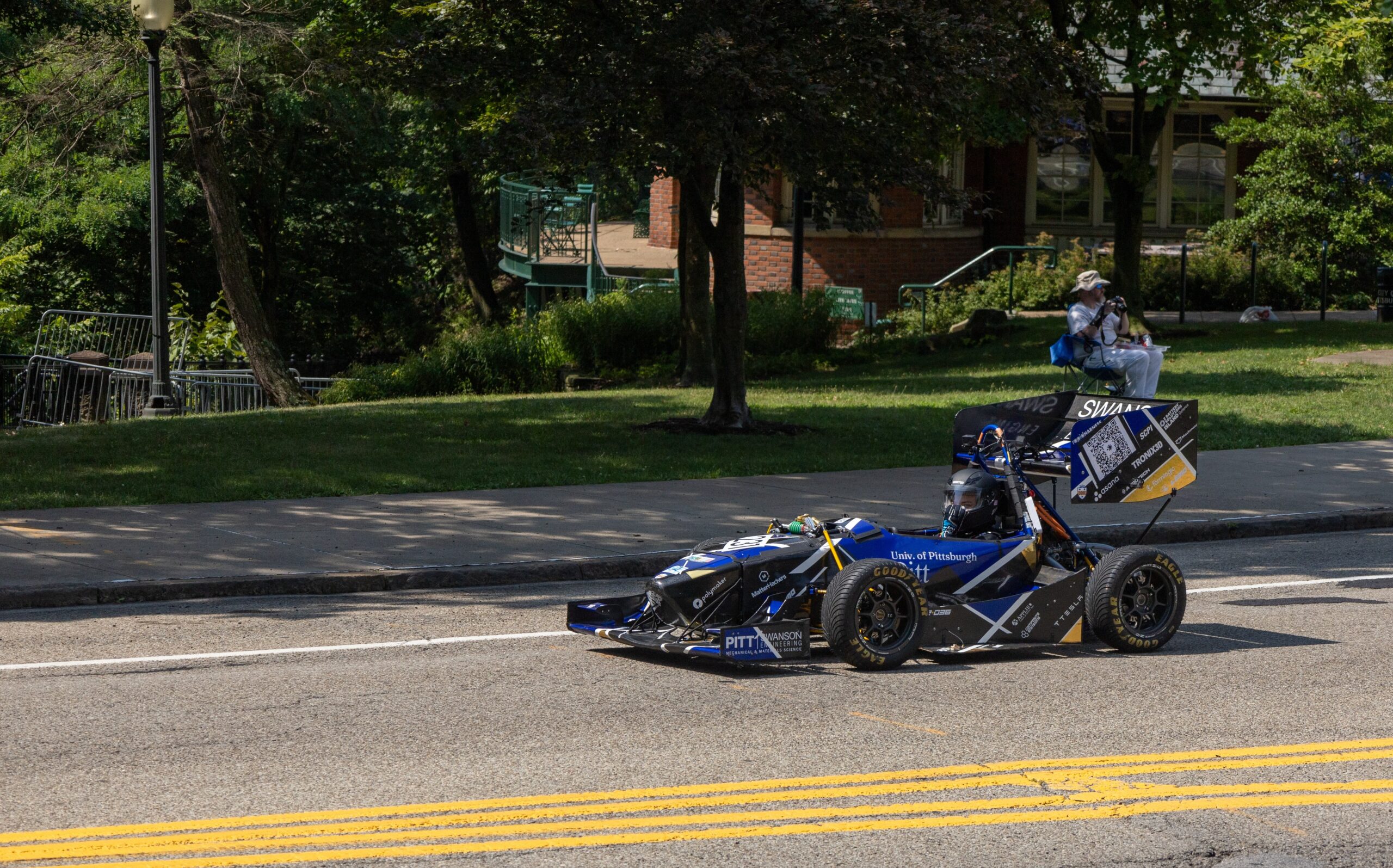Every detail matters in the racing world, where engineering excellence and speed converge.
At the recent Pittsburgh Vintage Grand Prix at Schenley Park, Italian classics like Ferraris and Lamborghinis were the stars of the show. That’s why Panther Racing’s sleek and modern formula car from the University of Pittsburgh made quite an impression.
It’s a cross-disciplinary effort, dating back to the mid-1990s at Pitt. The team came in eighth place at the 2024 Formula SAE competition in Detroit. Organized by SAE International, Formula SAE is a college-level engineering competition that challenges students to build and drive and Formula-style car.
The Formula SAE (FSAE) team from Pitt’s Swanson School of Engineering follows a well-oiled routine: They dismantle their previous year’s car, salvage useful parts, and build a new one with the latest technology. It’s a cycle of reinvention: design, build, test, and repeat, according to the student-led team at Panther Racing.

“Our first step is defining our targets,” Anita Kaul, electronics and integration lead, told Technical.ly. “This year, we’re focusing on reducing weight. That decision drives our design modifications and decisions.”
Once the design is finalized, the team moves into manufacturing, where they weld the frame and machine parts, and build both hardware and software systems. The manufacturing phase is where all the planning turns into physical reality.
Lastly, the team assembles the car in a strategic order to avoid issues while integrating. The culmination of this effort? A car that completed over 400 kilometers of testing before hitting the track.
Beyond engineering, the effort touches majors like nursing and marketing
Panther Racing blends students from diverse disciplines to create its vehicles.
“We have engineering students handling design and manufacturing, computer science majors working on software, and business students managing finances and marketing,” Kaul said.
A significant portion of the competition depends on business skills like managing finances and delivering presentations, including dealing with many corporate sponsors who offer discounts and materials for building the car.
The team’s focus on ergonomics and biomechanics also helps in integrating diverse expertise. For example, the team has a nursing major who’s developed a keen interest in electronics and brings a fresh perspective to the technical work.
“We use biomechanics to analyze muscle fatigue from steering and braking,” Anita said. “Our car is designed to fit a range of body types, accommodating both a fifth percentile female and a 95th percentile male.”
Each subsystem must seamlessly integrate with the others, demanding a high level of coordination, according to Kaul. The team holds four to five meetings weekly to ensure alignment across various components.
The team won awards for brake bias and battery design
Panther Racing’s student-led effort was recognized with the Cummins Innovation Award earlier this year for its advances in live telemetry, surface air pressure sensors and electronic brake bias.
“It isn’t at all like a regular passenger car, as the reclined seating makes seeing over the dashboard a bit more difficult.”
Helena Ciavarelli, powertrain integration lead at the Panther Racing team
Live telemetry allows real-time data for quick adjustments, air pressure sensors check aerodynamics and electronic brake bias fine-tunes braking control.
When faced with cooling issues for their batteries — a critical challenge due to heat generation — the team chose an unconventional solution.
“Instead of using air cooling, we implemented a water-cooling system with milled aluminum blocks and water channels,” Kaul said. This approach not only improved cooling efficiency but also significantly reduced charging times, allowing for more extensive testing.
Safety is also paramount in the design of the race car. Formula SAE imposes strict safety regulations, particularly for electric vehicles, according to Helena Ciavarelli, powertrain integration lead at the Panther Racing team.
The team follows more than ten safety interlocks that shut down the car if any issues arise. They also use the Tractive System Active Light, a visual indicator that confirms when the car’s electrical system is powered on.
Driving the car is an experience Ciavarelli describes as both exhilarating and challenging. Communication between drivers and the team is crucial, especially during testing, to fine-tune the car’s handling and dynamics.
“It isn’t at all like a regular passenger car, as the reclined seating makes seeing over the dashboard a bit more difficult,” Ciavarelli said. “Because of this, some of the most important driver qualities are the ability to focus on many things at once, remain calm in all scenarios and communicate effectively.”
Sponsorships and financial support pull prospective students in
The Formula SAE experience is a resume booster, too. Employers know FSAE students have hands-on experience in the field.
“Students have the space to see designs through, from concept to completion, and get a head start on many topics they may otherwise not encounter until they enter the workforce,” Ciavarelli said. “Participating in this competition teaches students how to innovate, work on a team, communicate effectively and meet deadlines.”
Funding is crucial for sustaining the team’s efforts. The university provides substantial financial support, which not only helps cover many of their expenses but also aids in attracting new engineering students to the school.
“Our shop and work on the racecar are part of the campus tours for prospective students, showing them the hands-on, real-world experiences they can be part of at Swanson School of Engineering,” Ciavarelli said.
The team also maintains strong relationships with its many corporate sponsors by actively promoting them through their marketing and social media teams. You’ll see names like Aerotech, PPG, Asana and Innovative Autoworks popping up in their promotions.
After securing ninth place out of 77 teams for the 2023-2024 season, the team aims to break into the top five in 2025. Upcoming events in Pittsburgh and Toronto will serve as preparation for next year’s big race in June at the Michigan International Speedway.
“We’re targeting 600 kilometers of testing before the next race,” Ciavarelli said. “As the saying goes, aim for the moon; if you miss, you’ll land among the stars.”







